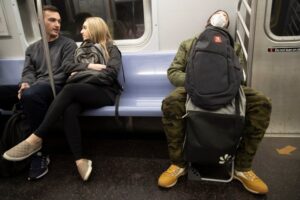
Imagine you are returning to public transport for the first time in months. Fellow passengers are neatly distanced, and the vehicle is sparkly clean. But then, at the next stop someone boards and they are not wearing a face mask. What should you do?
Should we regard him or her any differently than someone who drives their car without seatbelts or someone who goes to a bar, has a few drinks and then tries to drive home? Today both of these actions would be considered antisocial. Not wearing a face covering on public transportation should be regarded the same way, says the president of the Royal Society* in the UK (like the US Academy of Sciences). It’s a novel idea for novel times.
Surveillance or Stare Down?
But, even though most states with large public transportation systems have mandated that riders wear a face mask, how should they enforce it? When people surge through the ticket stiles or wait on the boarding platform, it’s relatively easy to surveil them.
But, once they board, riders can pull down their mask or take them off entirely. At that point, it becomes a stare-down between passengers who are in compliance and the offender. So, how do you return to public transport?
First, we need to address this issue because riders who do not comply threaten the return of public transportation and hijack the system for everyone else. There are a few methods: Initially, recorded messages, reminders over the public- address system and prominent signs in each vehicle help. Responding with kindness and offering the offending rider a fresh mask may work in some instances. But tech may be the final solution. France is using AI to detect people without masks. Or, more low key, fellow passengers can report the incident, by sending a picture and text to a dedicated number monitored by the transit police. Then, similar to a procedure used by airlines, ground personnel are summoned at the next scheduled stop to escort off the offender.
Floppy Dogs and Face Masks:
But, meanwhile, there is a second problem to resolve and it has a lot in common with the big floppy dogs you see flying in coach on airplanes and handicapped parking stickers on racy sports cars. There will always be a segment of the population that pulls a canard for their personal exemption. Perhaps their glasses fog up or the elastic straps from the face mask cut into their skin. Reasons will proliferate, just like the number of “emotional support dogs” we trip over in public.
Make no mistake, there are legitimate problems with facial masks. The deaf use facial and mouth communications to communicate. Masks may accelerate respiratory issues or feelings of claustrophobia. So, how do we differentiate between the good and the bad and know that the person not wearing one is doing so legitimately?
Dealing with Outliers:
A doctor on a Covid medical task force in Texas put it this way: …”with mask wearing the symptoms might get worse for people who experience oxygen depletion or have an allergy-induced asthma. However, people with these health concerns now should probably not leave home either. If they are in public and get infected, they are in the highest risk group.” Perhaps as conditions improve, public health officials can issue these afflicted riders with a safe alternative, like a clear face shield.
Requiring people to wear a face covering over their nose and mouth when they ride public transport should not be any different than requiring them to wear shoes and a shirt. These days, returning people to work on public transportation and making them feel safe when they do so should be our number one concern. This effort could be easily derailed by a few scofflaws and outlaws. It’s odd that something so necessary could depend on wearing a 4X6 piece of material in public.